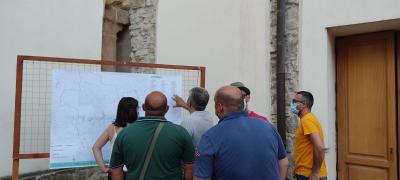Description
The BiodiverCities project in Regalbuto was an opportunity to implement an innovative process, for the first time in the city, of co-production of public policies on a municipal scale. Although Regalbuto signed the Simeto River Pact (SRA) in 2015, the participatory planning process has always been implemented on a territorial scale that includes 10 other municipalities in the Simeto basin.
The co-designing process of the city's Strategic Development Plan was an opportunity to work on two interconnected trajectories.
1. A substantial re-invention of a possible future and the valorisation of existing bio-richness;
2. The consolidation of a 'new alliance' between people and nature that goes beyond utilitarian concepts of ecosystem services and green infrastructure, establishing nature as a partner as well as an object of care and concern, understanding green spaces as 'ecological devices' (Raciti and Saija 2018, doi.org/10.1016/j.jum.2018.04.005).
During the implementation of the BiodiverCities project, citizens and institutions worked together to co-produce services (as Elinor Ostrom defines co-production) in the design of integrated local policies, to identify shared short-, medium- and long-term goals and projects, to initiate one or more priority actions. Throughout the process, attention will be paid to the relationship between people and nature inside and outside the urban centre and attempts will be made to improve the links between man and nature in order to begin to imagine a possible future in which there is not a utilitarian perception of nature, but a new interspecific solidarity.
Considering the European Recovery Plan, during the process it was deemed appropriate to elaborate a Strategic Development Plan consistent with the general framework of the Italian National Recovery and Resilience Plan (PNRR). This decision was considered fundamental in order to make the plan, one of whose objectives is biodiversity, declined as 'ecological transition'.
The process was divided into four different phases. During the first phase (outreach), interviews were conducted with key actors, representatives of organisations, associations, schools, parishes, farmers and local artisans. The second phase was aimed at broadening citizen involvement and participation: this was done with door-to-door street interviews in the different neighbourhoods. The third activity - the community mapping initiative - lasted six months, from August to December 2021, and involved a total of 280 people, involving associations, schools and organising open house events in Regalbuto's main squares. The community mapping initiative was organised as an interactive activity in which participants could work with maps and share issues related to strengths, weaknesses, memories and ambitions/desires about the future. The last participatory activity was a public event, a collaborative workshop to co-design the local development strategy.
When and Where
Policy Context
Participants
Methodologies
- interviews with key actors and focus groups: the interviews lasted between 40 and 60 minutes, the focus groups with young people and the elderly lasted 2 hours; the activities were facilitated by the expert with the support of 2 members of the participatory presidium and 1 sociology trainee;
- resident interviews: in this case the interviews lasted 15-30 minutes for each person and were conducted by five civil service volunteers with a specific protocol;
- community mapping initiative: each open house activity lasted a total of 2 hours, but each participant was engaged for 15-20 minutes during which facilitators supported participants in interacting with the map. To map, people had to sign a place and write on 4 post-it notes what they "like", "don't like", "liked it but now it is gone", "wish it was there in the future";
- collaborative workshops: the groups were facilitated not only by the BiodiverCities project team, but also by researchers from the University of Catania, with whom the municipality signed an agreement to support the next stages of the process. The event lasted for a total of 2 hours, the participants first discussed in separate tables on transformative scenarios on different topics, and then the various groups confronted each other in a plenary session.
All the data and input gathered in the various stages of the process were collected, analysed and organised in the form of a strategic development plan for the city that was officially approved by the administration.
Impact
Preface
1. Why a Municipal Strategic Plan Today
2. The planning process
3. A bit of history
4. What the data tell us
5. Regalbuto, as seen by its inhabitants (this part contains all the feedback gathered from the discussion with citizens during the process - interviews, focus groups, community mapping)
6. Regalbuto towards the 21st century (this section highlights all the citizens' aspirations and wishes)
7. Priority and integrated projects (outcome of the co-design workshops)
8. Recommendations for implementation
The Plan was officially approved by the municipal council and is one of the municipal planning documents.
Assessment
The second lesson concerns PA: a strategic plan that looks at social and environmental development from an integrated perspective cannot be designed by institutions that are organised by standard sectors. Looking at the complexity of society also means questioning the standard organisation and finding new forms of cross-sectoral interaction.
The third lesson concerns resources: involving citizens in open policy-making processes requires innovation in the approach and method by which institutions work. Such a change requires a deliberate investment of economic resources, both in metropolitan and marginal areas, it is a matter of political choices.
The second recommendation concerns unforeseen events: interpreting them creatively can help improve the quality of the process. Always having the possibility to change forecasts can be the success factor of a process.
The third recommendation concerns 'bricolage': change takes time, innovation has a better chance of success if one starts from existing strengths - even if they are fragmented - and puts them together step by step with careful 'bricolage'.
